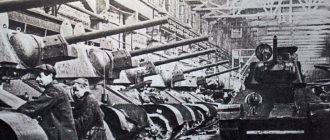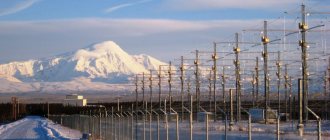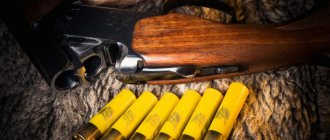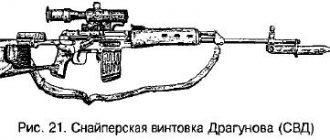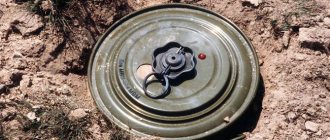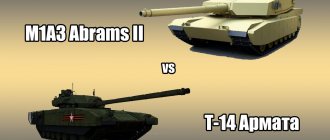German mortar mines
Fuzes Wgr.Z38 with detonator cup Kl. Zdlg. 34 and without it (for 5cm mortar mines)
A fuse is a device for activating ammunition. Without it, an explosion is impossible or difficult. During World War II, a huge variety of fuses were produced. German fuses stood out for their particular complexity.
German mine fuses during the First World War worked quite well, but their biggest drawbacks were the complexity of the device and the lack of instantaneous action, which did not give the proper effect when hitting targets with shrapnel. Taking into account the experience of the war of 1914-1918, the Germans imposed the following major requirements on the mine fuses newly developed before the Second World War: 1. Failure-free arming of the fuses when firing with all charges and the mandatory installation of fuses that are turned off before loading (travelling mount) to ensure safety when official handling of ammunition. 2. Instant action and high sensitivity of the ular mechanism. 3. Double action of the impact mechanism to ensure the reliability of the fuse at the target. 4. Long-range cocking of the striking mechanism. This is necessary due to the high sensitivity of fuses to instantaneous action and due to the tactical features of the use of mortars (their frequent location in firing positions in infantry combat formations, etc.).
Fulfillment of these requirements led to the creation of the Wgr fuse. Z. 34 instantaneous and inertial action with long-range cocking, carried out by a fuse from a visa-free composition. The fuse did not have special fuses that could be switched off before loading, so to ensure safety in official handling, mines with this fuse were to be stored and transported with the head part down.
German aluminum head fuze
model 38
Disassembled fuze Wgr. Z.38
The next mine fuze development was the Wgr.
Z.38, very successful in terms of safety and reliability of operation. From Wgr. Z.34, it differs favorably in that even when fired with a cocked inertial sleeve, the fuse does not cause a premature rupture in the mortar barrel. The mechanical principle of long-range fuse arming is based on the use of forward force; the fuse is cocked at a distance of about 5 m from the mortar. The safety requirements for official handling are the same as for the Wgr fuse. Z. 34. The inertial sensitivity of the fuse was increased by increasing the weight of the striker. Fuzes WgrZT and WgrZ38 with detonator glass
Gr. Zdlg 98 (for 8cm mortar mines)
German mortar mine fuze Wgr. Z. T
Considering the complexity of manufacturing fuses Wgr. Z.38
, the Germans are developing a new plastic mine fuse
Wgr.
Z. T. The new fuse is essentially no different from the
Wgr fuse.
Z. 38 . The only difference is the greater sensitivity of the fuse to instantaneous action, obtained by reducing the weight of the striker and using the forward force to move it.
Mine fuze Wgr.ZT
Due to the large number of fuse failures when a mine hits soft ground or snow, the Wgr.ZT fuse began to be widely used only in 1942, when there was a shortage of Wgr.Z fuses. 38
Fuse diagram for Wgr.ZT
For use with 105mm high-explosive fragmentation mines with Wgr fuses. Z.38
and
Wgr.
Z. T. had a serious drawback due to the impossibility of setting it to slow down.
Because of this, the Wgr fuse was later developed for 105mm high-explosive fragmentation mines.
Z. 36 with deceleration setting.
For long-range cocking, a fuse made of a gas-free composition is used in the fuse, as was previously the case in the Wgr fuse.
Z. 34. By this time, gas-free compositions of satisfactory quality had been developed in Germany and the opportunity presented itself to increase the size of the fuse, and therefore increase the weight of the inertial striker.
As a result, the disadvantages inherent in previous fuses in the Wgr.
Z. 36 were mostly eliminated.
Wgr.Z.38 G
The same as Wgr.Z.38 but the fuze body is stamped
Wgr.Z.38 C Head fuze of instantaneous and inertial action. To fragmentation, smoke and chemical mines for 50-, 81-, 105-mm model 35 mortars and to smoke and chemical mines for 105-mm mortars model. 40
German fuze Wurfgranatzünder Wgr.Z.38 C
History of mine weapons. What was one of the advantages of the USSR over Germany in 1941–1945?
Go to the previous part of the article
When tanks advance on prepared enemy defenses, they may well find themselves facing minefields. The sappers of the defending side place them, and the sappers of the attacking side, under enemy fire, try to remove or neutralize them. The tactics of sappers depends on what mines make up a given minefield.
Mines are anti-tank and anti-personnel. There are also special mines. There are a huge number of types of special mines in explosives, including anti-vehicle mines, anti-vehicle mines, anti-train (railroad) mines, anti-landing mines, and signal mines...
For simplicity, we will limit ourselves to anti-tank mines.
In the USSR and Germany, such mines began to be developed in the early 30s. Naturally, Germany at that time had more powerful engineering potential, and therefore the mines were developed quickly and perfectly - for the purposes of the emerging blitzkrieg.
The TMi-35 mine was adopted by the Wehrmacht . It was metal, lentil-shaped, weighed about 10 kg, of which about 6 kg were explosives. It was an ideal mine for a blitzkrieg.
Tellermine 35 (Tellermine 35 Stahl (T Mi 35 St)) - pressure-action anti-tank anti-track mine Photo: ru.wikipedia.org
Here are the Pantsevaffe tank wedges rushing forward. Luftwaffe intelligence warns that enemy tanks are ahead. The infantry jumps from the trucks and quickly digs in. Sappers quickly and deftly lay minefields. The enemy attacks, hits mines, his tanks are on fire, artillery hits them from the rear of German positions, and small 37-mm anti-tank guns shoot at their sides from ambushes.
Having repulsed stupid attempts to interfere with the victorious march of the invincible Wehrmacht, defeating the enemy and gathering in columns, the enemy continues its victorious march. The last ones left on the former battlefield are the sappers. They quickly and carefully remove minefields that are no longer needed, put the mines that didn’t go off back into the boxes, load them onto trucks, and follow the columns of their Kriegs-kamerades to victory.
In such a war, a mine was required to:
- Reliably deprived the enemy tank of mobility.
- Easy to install.
- It was easily detected by a mine detector and removed.
- It was reusable, so that it would not be harmed by the cycle “bury it in the ground - keep it in the ground for a day or a week - dig it up, and it is ready for work again.”
A German sapper mines a road during a retreat near Moscow Photo: Source
The TMi-35 mine was suitable in all respects. It had only one drawback - it was very expensive to manufacture. Well, a capitalist cannot work at a loss. And during the war with the USSR, another of its shortcomings became clear: its production required finely rolled steel and a number of other materials, which during the protracted war quickly became acutely scarce.
And the supply of mines prepared for the war dried up quite quickly in 1941. And it was too difficult to restore it. In 1942, the TMi-42 mine , also known as “Tellermine” or a saucer mine, so named for its shape. It was much simpler than its predecessor, but still required finely rolled steel.
But in the USSR they took a different path. , YaM-5 mines were placed against tanks . A large wooden box, like a parcel box, inside there are explosives and an MUV push fuse (they say that in 1942 the Germans started producing this fuse for their anti-tank mines called ZZ-42).
Soviet sappers on the bank of a stream near Stalingrad. In the hands of fighters are YAM-5 anti-tank mines (box mine No. 5) Photo: Source
The YaM-5 mine was inconvenient to install and dangerous when removed from combat platoon. Instead, TMD-B , and by 1944 - TMD-44 . These were also wooden boxes - the approach to the fuse in them was simply optimized, it was covered with a glass stopper. Such mines were made in simple carpentry workshops, but their equipment required caution and special knowledge.
There was also a TM-41 mine . It looked like a saucepan. It was done on the same equipment. Instead of pots. Well, of course, equipping the mine also required a skillful and careful approach.
In 1941-1942, these mines were guaranteed to break the caterpillar of an enemy tank that ran into them. But in 1943 it turned out that the T-5 and T-6, if they ran over the edge, could maintain mobility, albeit on a damaged track. Having learned about this, Soviet sappers simply began to place 2-3 more bombs under the mine, increasing the total amount of explosives by about 1 kg. The mines improved in this way were guaranteed to explode the tracks of both the Panthers and the Tigers.
So what was the advantage of the USSR over Germany? In the USSR, military designers, when creating new mines, guns, aircraft, etc., did not think that what they were creating should bring the greatest profit.
Soviet aircraft designer S.V. Ilyushin talks with test pilot V.K. Kokkinaki Photo: Source
If German designers had sought to make weapons or ammunition cheaper and larger, I’m sure they would have done it much better than in the USSR. But this was impossible; German military production had to bring the maximum possible profit to its owner. After all, war was seen by our opponents as a means of maximizing enrichment. As the great Goethe said:
Robbery, trade and war, does it really matter? Their goal is one!
During the production of ZIS-3 guns, the labor intensity of their production decreased by 3 times! Soviet anti-tank mines required 10 times fewer man-hours for their production and did not require thinly rolled steel or scarce non-ferrous metals. The incentive to make weapons or ammunition cheaper existed only in the USSR. German businessmen simply made money in the production of weapons and ammunition. And in the war with the USSR this became one of the reasons for their defeat.
Tags: World War II, explosives, military affairs, USSR, Germany, tank, weapons, explosives, minefield
German fuze Wgr.Z.36
Head fuse of instantaneous and inertial action, with a delay setting (0.15 sec.) and with long-range cocking, carried out using a spring stopper and a gas-free fuse.
The fuse is cocked at a distance of about 15 m from the mortar muzzle. The fuse is equipped with a travel pin, which can be removed before loading. New fuses have a plexiglass window through which a safety pin with a red stripe is visible. If the red stripe is visible, the fuse is cocked. Fuse delay device Wgr.
The Z. 36 is constructed using standard parts also used in head fuses.
The safety of the fuse in official use was ensured by setting a pin that was turned off before loading. Fuze Wgr.
Z. 36 generally satisfies the requirements for safety and reliability, but is extremely complex and expensive to manufacture.
Wgr.ZR Wurfgranatzünder R
Used in 8cm mortar mines WGR 8 cm
In the German army, the most common were four detonating devices: Kl. Zdlg. s/34
(small detonator sample 34),
Kz.
Zdlg. s/98 (short detonator sample 98),
gr.
Zdlg. s/98 (the same, but larger) and
Zdlg.
s/36 (detonator sample 36).
These detonators have a standard detonator capsule and differ from each other in size, weight and type of explosive detonator. The 5cm German mortar mines used a Kl detonator.
Zdlg. s/34 , and in 8cm mines
gr. Zdlg. s/98 Detonator Kl.
Zdlg. 34
In detonators Kl.
Zdlg. 34, pressed phlegmatized heating element painted pink (the so-called “pink tol”), hexagen or picric acid were used.
German detonator Kl. Zdlg. 34
Stamps on the bottom of the detonator - the letter code of the plant and the type of explosive in the detonator Np 10 Ten (German abbreviation Np
- nitropenta) phlegmatic - color from pink to orange. Designed for the manufacture of mixed explosives and detonators (detonator capsules, additional detonators, etc.) PHLEGMATISATION of explosives - reducing the sensitivity of explosives to mechanical influences (impact, friction, heating, shock wave effects, etc.) by introducing phlegmatizers into the composition of explosives, in this case, mountain wax.
Achtung, minen!
Looking at other countries, we remembered about mines. Naturally, he created a good anti-tank mine, Tellermine 29. But for some reason the sappers were arguing.
“You try to quickly install three fuses in the field!”
Well, OK. One fuse was left. And under the name Tellermine 35 and 35 St they issued ammunition to the unit.
On a sunny day, the French, who were looking at the Siegfried Line through binoculars, noticed that the Germans were burying something there.
-What do you have? — We plant potatoes. -...why is it so big? - So it’s a new variety.
French sappers inspect German Tellermine 35 St anti-tank mines taken on the Siegfried Line (photo source)
The French dug up a couple of “potatoes” for testing and realized: they urgently needed the same ones. But alas! The industry failed to cope with the new tasks and was unable to establish mass production. And the explosives in the mines that were supplied to the French troops tended to become damp and not go off.
In general, when the Germans made passages in their “garden,” their tanks happily and quickly went to France.
Detonator Gr. ZDLG. C/98 NP
Detonator Gr. ZDLG. C/98 Np from a German mortar mine 8cm
Detonators Gr.
ZDLG. C/98 Np from a German 8cm mortar mine The most widely used gr. Zdlg. s/98 of the next device. A detonator weighing about 35 g is pressed into the aluminum shell. Powdered picric acid was first used as a detonator, and then phlegmatized heating elements (gr. Zdlg. s/98 Np) or hexagen (gr. Zdlg. s/98H). A standard detonator capsule is inserted into the socket in the detonator, on top of which a circle of parchment and a pad of leather or pressed cardboard are placed. The edges of the shell roll up.
GR.ZDLG C/98 for 8 cm mortar mines
Detonator packaging
Pack of 5 gr.Zdlg detonators. C/98
Brand gr.Zdlg. C/98 F
on packaging
Wooden box for detonators
Pack of 25 Kl detonators. Zdlg. 34
In Soviet Russia
The USSR also loved to experiment. If at the beginning of the Winter War in our country the main anti-tank mine was the TM-35 (square and awkward), then after the end of the conflict the designers produced a whole horde of various ammunition.
- What's this? - Mina. Anti-tank. Anti-track. In a wooden (TMD-40) or metal case (TM-39). - It’s long! - Which one do you need? - Round! With a handle. - Here you have a handle (we spied this from the Finns) - PMZ-40. Here without the handle (TMB)... Here we will supply you with some more old TM-35... - And where do we need this “zoo”? - Well, in case it comes in handy...
Soviet sappers go out to install PMZ-40 anti-tank mines near Leningrad (photo source)
"Edema"
Entered service in 1986. The tension-action anti-personnel fragmentation mine POM-2 “Otek”, like PFM-1, is installed on the ground using the remote mining method. The peculiarity of this weapon is its independent “character”. After the POM-2 falls to the ground, the process of bringing it into combat position begins, which lasts about a minute. First, the locks of six spring-loaded blades open, which, leaning to the sides of the body, lift it to a vertical position. Then, from the upper part of the body, four anchor weights are shot in different directions, pulling thin broken wires behind them. From this moment, the mine is in a combat position, and the countdown of combat operation time begins, which can range from 4 to 100 hours. After this time, the ammunition self-destructs.
POM-2 A mine explodes when any of the four wires breaks. The radius of continuous destruction is up to 16 meters. POM-2 provides all-round engagement of targets. At the same time, it is impossible to remove it - “Swelling” is non-removable and non-neutralized.
"Petal"
The PFM-1 Lepestok anti-personnel high-explosive mine is never installed on the ground manually. These small explosive devices, each weighing only 800 grams, are made of polyethylene and are scattered over the area using remote mining. In Afghanistan, Soviet Su-25 attack aircraft “seeded” problem areas with them. A brown or green silhouette 12 centimeters long and 6.5 centimeters wide cannot always be seen on the ground, especially in the dark.
“Butterfly” high-explosive anti-personnel mine PFM-1 (“Lepestok”) “Petal” is a cruel mine. 37 grams of explosives are not guaranteed to kill a person; the damage is caused by injuring the lower part of the leg. During the explosion, practically no lethal fragments are formed, with the exception of the metal parts of the mechanism in the central part of the mine. However, the foot is completely torn off. A unit that runs into a minefield quickly loses its combat effectiveness. The wounded person must be bandaged and taken to a safe place. It is hardly worth clarifying that the demoralizing factor of the insidious “Petal” is enormous.
